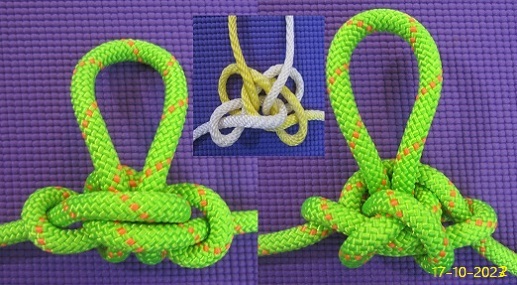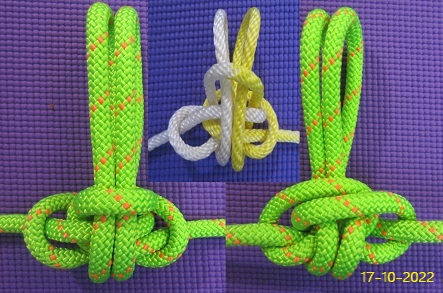Hi All, Just like share how I tie Double Alpine Butterfly Loop.
Hope you like it.
Here is the video https://www.youtube.com/watch?v=iD0TxJMK1t8&t=406s
Another Double Alpine Butterfly tie with New 7/16" Bluewater Safe Line.
https://www.youtube.com/watch?v=-6x1QQYPT14&ab_channel=alanleeknots
Alan,
I love the second video. In it, you very nicely show how to set the size of the two loops as you do the wraps. Most hand wrap methods just sort of pull out enough in a not very obvious way in the middle of the tucking process.
It is also easy to see how you could use a very similar method for getting a single loop (or for getting three loops).
Thanks for sharing this!
Dennis
Hello Alan,
Very nice video presentations - steps are clear and easy to follow (and understand).
Of interest to me (and rope technicians) is how to arrive at a ‘double Butterfly’ by starting from base #1053 Butterfly.
Dennis Pence has demonstrated to it is possible to transform a #1053 Butterfly into a double eye version without untying it.
As far as I am aware, there are only 2 different ‘double eye Butterfly’s’.
They both have different geometries - the ‘girth hitch double Butterfly’ allows quick and easy attachment of a pulley.
Dennis has found a way to add a pulley to the other double eye version - but - there is a twist/overlap in the eye legs.
I am hoping to find a way to attach a pulley without overlapping/twisting the eye legs.
So just to be clear… of real interest is being able to arrive at a double eye Butterfly by starting from base #1053 Butterfly (without untying it).
It is these techniques that I will add to my upcoming technical paper on the Butterfly.
It is a very useful and versatile knot!
Thanks again for your good work ![]()
Mark, Dennis: Thanks for both of your comments.
After seeing everyone tie these knots. here is how I would like to tie this knot, see the photo below,
never do any test yet, but I assume it will improve the overall jam threshold also retain the simple
Butterfly structure and with no any interferent. Thanks.
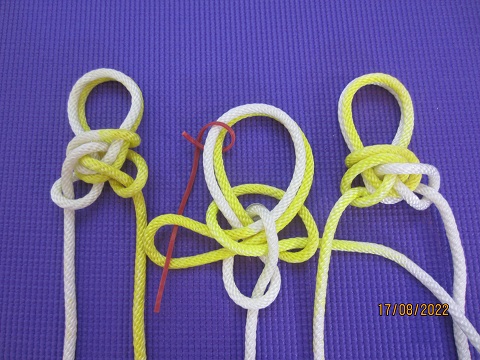
Nice!
.
To me, a standard BFly(Rigger, Zepp), is another illustration of how an Overhand’s most Natural/most best position is as a 90degree change from input to output of the architecture form, and extended to flat is then definitively the most leveraged/worst structural position etc.
BFly example kinda diploid Overhand gives other half of another 90, to be happy then at flat line input/output.
Best way to pull eye produced then is 90degrees from end pulls, folded down as typical for Trucker’s version etc. as again here too the worst angle of eye pull; as an inherited characteristic. This imbalanced/less sharing uniformly pull position on rest of structure makes it harder to untie etc.
Alan, Mark,
Sorry Alan, but I am not fond of the complicated knot you get when you transform a single Butterfly into a double loop knot in Reply 4. It is certainly not the traditional Double Butterfly.
I know that Mark is not happy with the method I proposed for inserting a ring or pulley into a Double Butterfly (in Dual-loop Butterfly tying (igkt.net) Reply #7).
What Mark wants is a way to insert a ring or pulley without any half twists. Below I show that this is not possible. In the diagrams, I tie a traditional Double Butterfly and insert a carabiner. Then I “untie” the knot without opening the carabiner.
As you can see, this “ring” does not come free. Even if you completely untie the resulting single Butterfly, this “ring” is still entangled in the rope.
Mark,
Here is an alternative to my previous method for inserting a ring or pulley into a single Butterfly to get a Double Butterfly. I do not like it as well as the previous method (which had one half twist). But some might like the greater symmetry because each loop has a half twist). You start with a single Butterfly with a half twist.

Hello Dennis / Alan,
Firstly - thank you very much for your efforts ![]()
It is appreciated.
per Alan:
For the presentation at reply #3 (Alan) - it is an interesting creation.
I like how Alan thinks ‘outside the square’ - I’ll have a closer look at this over the weekend.
per Dennis:
We have 2 different posts/threads with double Butterfly’s… its getting hard to follow and collate the progress made.
The example shown at reply #5 (using a carabiner) is an interesting way to establish a ‘proof’ - that avoiding twists/overlaps with the eye legs is not possible.
I’ll quote you here…
What Mark wants is a way to insert a ring or pulley without any half twists. Below I show that this is not possible.It is true to state that I would like to discover a way to add a ring (or pulley with a swivel eye) to one of the double eye Butterfly's without induced twists in the eye legs.
One thing I have realized in my life experience is to used the phrase “not possible” (ie impossible) with abundant caution.
There are incredibly talented people like Xarax and Alan Lee who have repeatedly demonstrated that the ‘impossible’ is merely an opportunity to show what is possible.
That’s not to in any way deride or ridicule Dennis Pence - quite the contrary!
I am both impressed and humbled by the progress and advances made by Dennis.
I remain cautiously optimistic that Dennis (or another creative genius) will discover a way to avoid twisted/overlapped eye legs in one of the double Butterfly’s.
The proof of the carabiner tying method is not necessarily a ‘show-stopper’… yet (I hope).
Note: The tying method depicted at reply #6 has a geometry that is almost identical to the ‘Girth hitched double Butterfly’.
Look at the geometry of the eye legs… note that for each ‘eye’, both legs are situated to one side of the knot core (ie 1 pair of eye legs lies on the ‘Z’ side and the other on the ‘S’ side).
I feel that you are possibly on the verge of some important discoveries - and I hope you have the motivation to continue.
Hi All, May be ? Thanks.
https://www.dropbox.com/s/uu7k5bs8fd20yqd/Double%20Butterfly%20hard%20to%20tie.MOV?dl=0
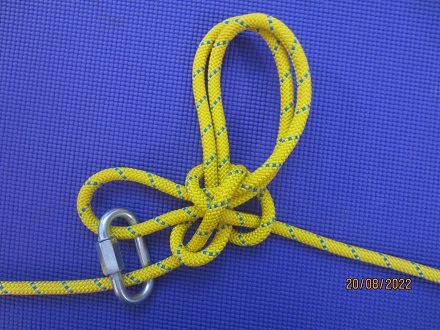
Alan,
Sorry I was somewhat negative about your Double Bowline (we need a name for it!). Now that I have played with it more and tried to modify it, I am more impressed with it.
Note below that it is easy to insert a ring or small pulley as you tie it. I experimented with a half twist of the bight that you pull the two loops through (in either direction). Doing so makes the turn in the rope less severe, but both of these are harder to tighten. I finally decided that I like yours the best. It also took me awhile to understand how to tighten it. I figured it out just before I saw your video. You show it nicely (as you often do in your nice videos).
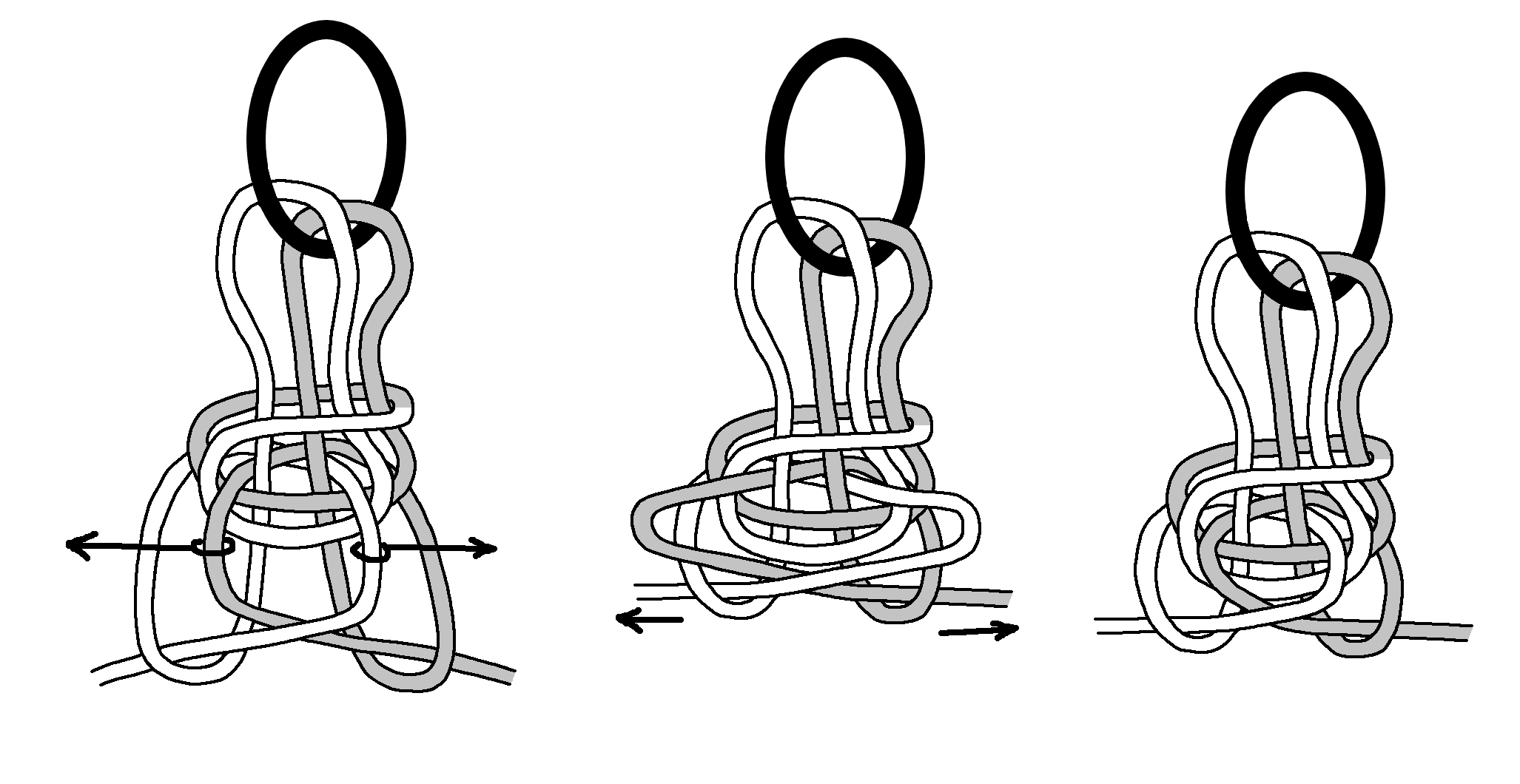
Hi Dennis, Thanks for your replied, the purple of giving half a twist on the eye loop is to add one
more rope diameter, make it totals 3 rope dimeter in the middle of the cross over of the right
side overhand knot, in the main time reduce the twist of the [s]right[/s] left hand side collar near the
standing part. Than this will make both side have a very close jam threshold.
Thanks.
Edit; O K, might as well bring all the information together here, don’t need to jump back a fore, easy to look at it.
https://www.dropbox.com/s/wvqkedw3s9zah7x/Tie%20Overhand%20knot.MOV?dl=0
https://www.dropbox.com/s/uu7k5bs8fd20yqd/Double%20Butterfly%20hard%20to%20tie.MOV?dl=0
HiAll,
This Double Butterfly loop "MG_001.JPG" failed to work.
Will bring in other solution, just need time to put it together.
I think we are asking little too much from this "Simple butterfly loop".
Thanks.
Hi,
Here is the loop, have a quick test.
[s] Left[/s] Right eye loaded with 1000kg can be untie around 2 minute.
[s] Right[/s] Left eye loaded with 1000kg can be untie around 3 minute
St to St loaded with 1000kg just start to jam, I think 800kg should be a problem.
Just so busy that all I can do for now. thanks
Hi All,
Quick way to improve the jam threshold.
Quick test;
St to St after loading with1013 kg and easy to untie.
[s]Left side[/s] Right side, after eye loadging with1017kg and easy to untie
[s]Right side[/s],Left saie after eye loadging with1025kg need 30 sec to untie
Thanks.
Hi All, here is the video how I tie the improved version of Butterfly Loop. Thanks
https://www.youtube.com/watch?v=jIRshLc6UjM
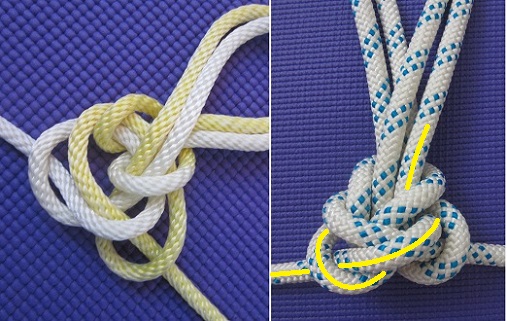
Alan,
I like your new Double Butterfly in Reply 12 and 14. But playing with it some I decided that I wanted a little more symmetry. Instead of inserting the bight to the side of the legs of the original loop, I like better to bring the bight down and up in front (which affectively puts it in the middle).
Both yours above and the one I propose below might take a little less rope to make the two loops compared to the traditional Double Butterfly, but they might not be as secure. It is also easy to insert a ring or small pulley for all of these.
Hi All,
When you guys start the topic, “Dual-loop Butterfly tying” reminds me it is about time to do something, so offer my friendly tying method. Also, offer what I know about the Butterfly knot and Overhand knot.
I don't know much about the Dual-loop Butterfly. I learnt some from you guys, and did some research from YouTube.
There are many variations out there. I like unique idea from Евгений Романенко.
See this "https://www.youtube.com/watch?v=2nZO2KVqPU0" and "https://www.youtube.com/watch?v=XujCv90Rt_gand ",
I combine other ideas, that means, basically, you can drop the loop of a Butterfly knot from the front or the back and also the finishing loop from either the front or back and turn into Dual-loop Butterfly.
Anyway, before I came up with my first Dual-loop Butterfly, I tested the popular traditional Dual-loop Butterfly, the jam threshold on the weak side of the eye loop, which is about 400kg.
My first Dual-loop Butterfly failed and the second one is decent. I just hope someone can test it on the field.
To Denis, both loops are secure and safe, and I don't deserve to have my name on the loop that you have posted.
Thanks.
My hand drawn images in Reply #15 do not do justice to the tightened knot. Further, what is pictured there is similar to the Girth Hitch Double Butterfly. You can add a half twist before tucking and get something similar to the regular Double Butterfly. Below are images of what this might look like.
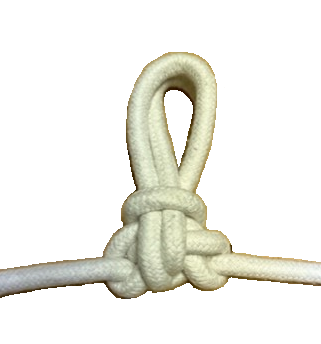
Two nice looking improvements Butterfly knots here. Both are easy tie and dress.
Need to test it for sure..
